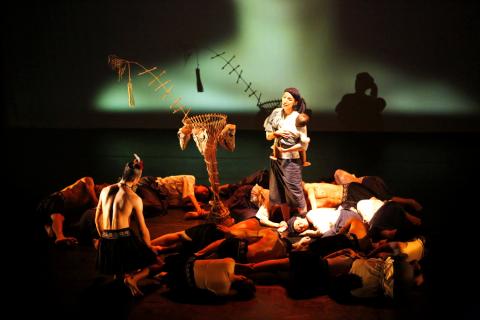Yi-Tzy Folk Dance Theatre (藝姿舞集) marked its 19th anniversary in February, an impressive record for a troupe based in Tainan, rather than Taipei or Kaohsiung. Company founder and artistic director Christina Kuo (郭玲娟) established the troupe a couple of years after graduating from Chinese Culture University’s dance department. After attending several dance festivals abroad, she decided that there was a need for a company that could promote Taiwan’s unique multi-ethnic heritage. Her work has focused on preserving and celebrating Taiwanese and Aboriginal traditional dances and customs from festivals and temple fairs. The group’s latest production, Ina (伊那), focuses on the traditions of the Siraya, an Aboriginal community centered in Tainan that has been fighting for official recognition from the central government. The then-Tainan County government recognized them as a distinct Aboriginal people in 2005. The title of the work, Ina, comes from the Siraya word for “mother.”
■ Tonight at 7:30pm, New Taipei City Arts Center (新北市藝文中心演藝廳), 62 Jhuangjing Rd, Banciao Dist, New Taipei City (新北市板橋區莊敬路62號)
■ Remaining tickets are NT$400 and NT$600; available through NTCH ticketing, online at www.artsticket.com.tw and at convenience store kiosks

Photo courtesy of Yi-Tzy dance theatre

This month the government ordered a one-year block of Xiaohongshu (小紅書) or Rednote, a Chinese social media platform with more than 3 million users in Taiwan. The government pointed to widespread fraud activity on the platform, along with cybersecurity failures. Officials said that they had reached out to the company and asked it to change. However, they received no response. The pro-China parties, the Chinese Nationalist Party (KMT) and Taiwan People’s Party (TPP), immediately swung into action, denouncing the ban as an attack on free speech. This “free speech” claim was then echoed by the People’s Republic of China (PRC),

Exceptions to the rule are sometimes revealing. For a brief few years, there was an emerging ideological split between the Democratic Progressive Party (DPP) and Chinese Nationalist Party (KMT) that appeared to be pushing the DPP in a direction that would be considered more liberal, and the KMT more conservative. In the previous column, “The KMT-DPP’s bureaucrat-led developmental state” (Dec. 11, page 12), we examined how Taiwan’s democratic system developed, and how both the two main parties largely accepted a similar consensus on how Taiwan should be run domestically and did not split along the left-right lines more familiar in

Many people in Taiwan first learned about universal basic income (UBI) — the idea that the government should provide regular, no-strings-attached payments to each citizen — in 2019. While seeking the Democratic nomination for the 2020 US presidential election, Andrew Yang, a politician of Taiwanese descent, said that, if elected, he’d institute a UBI of US$1,000 per month to “get the economic boot off of people’s throats, allowing them to lift their heads up, breathe, and get excited for the future.” His campaign petered out, but the concept of UBI hasn’t gone away. Throughout the industrialized world, there are fears that

The Democratic Progressive Party (DPP) controlled Executive Yuan (often called the Cabinet) finally fired back at the opposition-controlled Legislative Yuan in their ongoing struggle for control. The opposition Chinese Nationalist Party (KMT) and Taiwan People’s Party (TPP) acted surprised and outraged, but they should have seen it coming. Taiwan is now in a full-blown constitutional crisis. There are still peaceful ways out of this conflict, but with the KMT and TPP leadership in the hands of hardliners and the DPP having lost all patience, there is an alarming chance things could spiral out of control, threatening Taiwan’s democracy. This is no